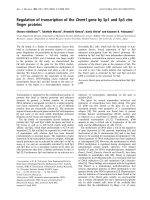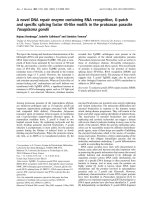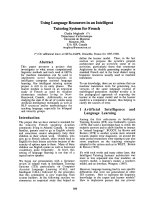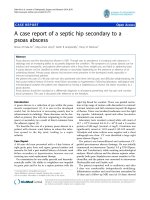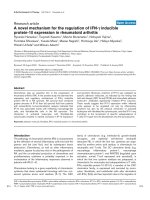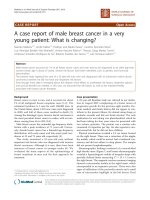Báo cáo y học: "A novel mutation in the ADA gene causing severe combined immunodeficiency in an Arab patient: a case report" ppt
Bạn đang xem bản rút gọn của tài liệu. Xem và tải ngay bản đầy đủ của tài liệu tại đây (740.77 KB, 5 trang )
Case report
Open Access
A novel mutation in the ADA gene causing severe combined
immunodeficiency in an Arab patient: a case report
Ali Hellani
1
, Nidal Almassri
2
and Khaled K Abu-Amero
3
*
Addresses:
1
PGD Laboratory, Saad Specialist Hospital, Al-khobar, 31952 Saudi Arabia,
2
Pathology and Laboratory Medicine Department,
Saad Specialist Hospital, Al-khobar, 31952 Saudi Arabia and
3
Molecular Genetics Laboratory, College of Medicine, King Saud University,
PO Box 245, Riyadh 11411, Saudi Arabia
Email: AH - ; NA - ; KKAA* -
* Corresponding author
Published: 1 April 2009 Received: 10 April 2008
Accepted: 23 November 2008
Journal of Medical Case Reports 2009, 3:6799 doi: 10.1186/1752-1947-3-6799
This article is available from: />© 2009 Hellani et al; licensee Cases Network Ltd.
This is an Open Access article distributed under the terms of the Creative Commons Attribution License (
/>which permits unrestricted use, distribution, and reproduction in any medium, provided the original work is properly cited.
Abstract
Introduction: About 20% of the cases of human severe combined immunodeficiency are the result
of the child being homozygous for defective genes encoding the enzyme adenosine deaminase. To our
knowledge, the mutation pattern in Arab patients with severe combined immunodeficiency has never
been reported previously.
Case presentation: A 14-month-old Arab boy had clinical features typical of severe combined
immunodeficiency. His clinical picture and flow cytometric analysis raised the diagnosis of adenosine
deaminase deficiency and prompted us to screen the adenosine deaminase gene for mutation(s). We
detected a novel mutation in exon 9 of the adenosine deaminase gene (p.Arg282>Gln), which we
believe is the cause of the severe combined immunodeficiency phenotype observed in our patient.
Conclusion: This is the first report of adenosine deaminase mutation in an Arab patient with severe
combined immunodeficiency due to a novel pathogenic mutation in the adenosine deaminase gene.
Introduction
Human severe combined immunodeficiency (SCID) was
first reported by Swiss workers more than 50 years ago [1].
Infants with the condition were profoundly lymphopenic
and died of infection before their second birthday. In the
ensuing years, differences in inheritance patterns were
noted, indicating causal heterogeneity of this condition. In
many families, there is a clear X-linked pattern of
inheritance, whereas in others there is an autosomal
recessive inheritance pattern. The first discovered
molecular cause of human SCID, adenosine deaminase
(ADA) deficiency, was reported in 1972 [2]. Infants with
this syndrome are lymphopenic and have profound
deficiencies of T and B cell numb ers and function.
Adenosine deaminase is an important deaminating
enzyme, which converts adenosine and 20-deoxyadeno-
sine to inosine and 20-deoxyinosine, respectively. Those
components are generated in large amounts from apopto-
tic cells in the thymus, marrow, and lymph nodes [3].
When ADA is absent, these nucleosides are metabolized
Page 1 of 5
(page number not for citation purposes)
differently and have distinct biochemical actions. The
incidence of ADA deficiency is about 1 in 1,000,000 births,
but it accounts for 10% to 20% of all cases of SCID. In
about a fifth of ADA-deficient patients, the immune
deficiency is initially less severe, presenting later in
childhood. A few older patients have recently been
diagnosed at 15–40 years of age with chronic pulmonary
insufficiency due to recurrent respiratory infections, and
other manifestations of immune deficiency and dysregula-
tion [4].
The genomic sequence of ADA gene spans 32kb on the
long arm of chromosome 20 and contains 12 exons [5].
More than 70 ADA mutations have been identified thus
far. The majority were missense mutations (63%), 18%
were splicing mutations, 13% were deletions and 6% were
nonsense mutations [6]. The amino acid substitutions are
distributed throughout the protein sequence. A few large
deletions have arisen from recombination between Alu
repeats, but most deletions are small and probably due to
replication errors. Most recurrent missense mutations arise
from codons that contain the CpG dinucleotide. This
report describes the identification of a novel base-
substitution mutation in the ADA gene along with the
associated phenotype, and the modalities of treatment
related to gene findings.
Case presentation
A 14-month-old Arab boy whose parents were first-degree
cousins was referred to our pediatric ward with a history of
frequent severe chest infections, chronic diarrhea and
failure to thrive. This family lost two children at the age of
6 and 8 months due to SCID. The patient was found to be
lymphopenic and further investigations confirmed severe
combined immunodeficiency with the first sign being
fever at 1 month of age. The cause of his immunodefi-
ciency was suspected to be ADA deficiency. He also had a
Mycobacterium intracellulare infection and was suspected
of having cytomegalovirus (CMV) gastroenteritis. He was
irritable, in compensated sepsis with respiratory distress
and his abdomen was soft with no palpable hepatosple-
nomegaly. He had a fine skin rash with no lymphadeno-
pathy and his BCG vaccination site showed a non-infected
old scar. The rest of his physical exam was normal. His past
medical history re vealed recurrent severe infections,
especially chest infections. He had had at least four severe
episodes of lower respiratory tract infection with bronch-
ospasm. Almost all of these episodes needed admission to
hospital and treatment with intravenous antibiotics.
History of the index case also included diarrhea with
loose stools 4 to 5 times daily. At 1 month of age, he
developed a bacterial infection easily cured with a course
of antibiotics. Investigations revealed mild hydro-uretero-
nephrosis and no evidence of vesico-ureteric reflux. Past
surgical history included a left inguinal hernia repair. Flow
cytometry (FCM) analysis was performed in order to
quantify the number of B- T-, and NK-cells. FCM results
showed near absences of lymphocytes with only 101 cells
per ml (2% of white blood cells). The lymphocyte subsets
were 88% T cells with a CD4 to CD8 ratio of 3; 5% B-cells
and 7 % NK-cells. Absence of the comm on g chain
(CD132) which is associated with X-linked SCID was
not evaluated. However, unlike our patient, X-linked SCID
patients characteristically have a T-B+NK-phenotype
which is different from our patient who has a T-B-NK-
phenotype. The latter phenotype is seen in ADA deficiency
[7] and hence prompted our evaluation and study of the
ADA gene mutation.
In order to assess the mutation causing SCID in this
family, genomic DNA was amplified and the entire coding
region and the exon–intron boundaries of the ADA gene
were sequenced. The primers used to amplify all 12 exons
of the ADA gene are summarized in Table 1. Briefly, ADA
sequences were amplified from 100 to 200ng of DNA
using specific primers (5mMdNTP (5mM), PCR buffer 10×,
and one unit of expanded long Taq polymerase (Roche).
Polymerase chain reaction (PCR) products were purified
using a Qiagen purification kit and then assessed with a
capillary electrophoresis bio-analyzer using the DNA 7500
chip. The purified PCR products were sequenced on an ABI
3130xI Genetic Analyze r using forward and reverse
primers listed in Table 1.
Predictions of the tolerance of the protein to the mutation
were assessed using SIFT (Sorting Intolerant From
Tolerant) programs ( />html) and Protean (Protein Structure Prediction and
Annotation; LASERGENE V.6 software DNASTAR, Inc.,
Madison, WI, USA). Protean helps to predict and display
patterns, secondary structural characteristics and physio-
chemical properties (hydropathy index and flexibility
prediction). The study has been reviewed by the Evidence
Based Medicine and Research center of this institution.
After sequencing the entire ADA gene, we detected a single
nucleotide substitution (c.847G>A) in exon 9 of this gene
(Figure 1). This nucleotide substitution resulted in the
replacement of Arginine (Basic hydrophilic AA) with
Glutamine (Neutral AA) at codon 282 (p.Arg282>Gln)
thus altering the hydropathy index from 0.48 to 0.37.
Protean predicted a change in the amino acid structure and
this may affect the function. The mutation was located in
the active domain of the protein, which extends from
codon 8 to 346, thus it was expected to affect the
deaminase activity of the enzyme. SIFT predicted that the
AA change at this location could not be tolerated, and thus
it is highly likely that it will have an effect on the protein
structure and/or function. This sequence change was not
detected in 50 unrelated controls of similar ethnicity.
Page 2 of 5
(page number not for citation purposes)
Journal of Medical Case Reports 2009, 3:6799 />Based on the above findings, we strongly believe that this
sequence change is probably pathogenic.
Discussion
The mutation is a G to A transition at a CpG dinucleotide,
CGG to CAG, and is therefore a “hotspot” mutation, as
over half the missense mutations are at the ADA locus [8].
Methylated cytosine can spontaneously deaminate to
thymine, resulting in a C to T transition if the deamination
initially occurs on the coding strand and a G to A transition
if the alteration initially occurs on the non-coding strand.
Since methylation of cytosine in man occurs virtually
exclusively at CpG dinucleotides, CpG dinucleotides are
hotspots for mutations. Despite being a hotspot mutation,
the mutation identified in this report is novel. Moreover,
this is the first report of a mutation in exon 9 of the ADA
gene where mutation(s) are rarely present [9, 10]. We
believe that this mutation is the cause of the SCID
phenotype observed in our patient for the following
reasons: i) it is the only mutation found after sequencing
the entire ADA gene; ii) both parents were heterozygous for
this mutation; iii) the affected individual was homozygous
for this mutation; iv) the location of the mutation and the
SIFT prediction; v) alterations in the hydropathy index and
vi) the fact that this mutation was not found in 50
individuals (100 alleles) from matching ethnicity.
The effects of mutation on the ADA would be more
precisely assessed by measuring, i) the level of soluble
ADA activity and ii) the immunoreactive ADA protein
expressed by ADA cDNAs in E. coli, which has a deletion of
the bacterial ADA gene [11]. The concentration of wild-
type ADA and the activity of the mutated enzyme are
expected to be extremely low since SCID is present in all of
the affected members of the family. Indeed, Hershfield
suggested that patients whose two alleles together provide
≤0.01% of wild-type ADA activity have SCID; those with
0.1% to 0.3% have delayed or late onset SCID; Further-
more, those inheriting alleles that provide ≥5% of wild-
Table 1. List of primers covering the entire exons and intron–exon boundaries for the ADA gene
Exon Primer sequence Tm (°C) Size (bp)
1 F-5
0
-TGTGTGTTTCTGCGACGAGC-3
0
R-5
0
-TGTCCCTGATTAGCCCGCAA-3
0
55 692
2 F-5
0
-GCAGCCAGCCAGTAAAATG-3
0
R-5
0
-TGTCCTCACAGTCCCACTTC-3
0
55 366
3 F-5
0
-GTCCACCACTCACTGTTTTG-3
0
R-5
0
-AGTCCATCACACCCACATC-3
55 384
4 F-5
0
-TGTTCCCAACCCCTTTCTTCC-3
0
R-5
0
-AAATGGGCCAGACTCACTTCAG-3
0
55 556
5 F-5
0
-CCCAAAGCCTCCTCTTCCTCCT-3'
F-5
0
-AGGTCTCCAGTTGTTTCATG-3
0
55 377
6 F-5
0
-TAGGCTGGGAGGTCTCTC-3
0
R-5
0
-ACCCAACAAAGACACACTC-3
0
55 315
7–9 F-5
0
-ATGCTGTTGAAGCAGGCAGCATGACTAGGA-3'
F-5
0
-TGCCTGCTTCCCAGGGTGTCGAAGAGATTT-3
0
60 739
10 F-5
0
-AGGATCAAAGGCGGGTGAAC-3
0
R-5
0
-TCCCTCTCTCCAAAGATTCCAG-3
0
55 312
11 F-5
0
-AGGATCAAAGGCGGGTGAAC-3
0
R-5
0
-TCCCTCTCTCCAAAGATTCCAG-3
0
55 238
12 F-5
0
-TCTGAAGCCCAGTCCCAAAG-3
0
R-5
0
-AAATGTTGCTCAGCCCCAC-3
0
55 363
Corresponding Tm and size in bp are indicated. PCR conditions as described in the case presentation.
Figure 1.
Chromatogram presenting the sequence of exon 9 of the ADA
gene, where the mutation was detected. The mutation
involves the substitution of nucleotide G by A. The parents
and sister (A) are heterozygous for this mutation; the affected
child (B) is only showing nucleotide A while in normal DNA
(C) only nucleotide G is present. The nucleotide changes are
marked.
Page 3 of 5
(page number not for citation purposes)
Journal of Medical Case Reports 2009, 3:6799 />type activity remain healthy [3]. Three types of therapy are
available for patients suffering from ADA deficiency: bone
marrow transplant, enzymic treatment and gene therapy.
Hematopoietic stem cell transplantation (HSCT) from a
human leucocyte antigen (HLA) -matched donor offers
good immunological and biochemical correction with
survival ca.85%, but in the mismatched donor setting, the
outcome is significantly worse. Pegademase (PEG)-ADA
enzyme replacement therapy is used when a matched
donor is unavailable. Although overall survival is good
[12], immune reconstitution is variable and prolonged
treatment results in significant lymphopenia, variable
defects in T cell function including decreased thymic
output, and susceptibility to viral infection. Initial retro-
viral vector-mediated gene therapy trials for ADA-SCID
demonstrated efficient transduction of hematopoietic
progenitors and long-lived expression of the ADA gene
in transduced T-lymphocytes, but immune reconstitution
was poor and most probably compromised by the
concomitant use of PEG-ADA, which abrogated the
survival and growth advantage of gene-modified cells
[13]. The success of gene therapy for ADA-SCID has
recently been shown in patients who did not commence
PEG-ADA and who received a non-myeloablative che-
motherapy regimen [14]. It is likely that the lack of PEG-
ADA restores a survival advantage to transduced lympho-
cytes and that chemotherapy allows increased engraftment
of gene-transduced progenitors. The patient described in
this report is benefiting from the HSCT program where his
sister, a carrier for the currently reported mutation, is a
matching donor. The family is benefiting as well from our
preimplantation genetic diagnosis [15, 16] facility where a
future pregnancy would be free of ADA deficiency.
Conclusions
The promising success of hematopoietic stem cell transfer
and gene therapy in patients with adenosine deaminase
deficiency provides tremendous hope for the patients and
their families. Identifying adenosine deaminase gene
mutation(s) involved in the severe combined immunode-
ficiency is a key element for any subsequent treatment.
This is the first report of adenosine deaminase mutation in
an Arab patient with severe combined immunodeficiency.
Abbreviations
ADA, adenosine deaminase; CMV, cytomegalovirus; FCM,
flow cytometry; HLA, human leucocyte antigen; HSCT,
hematopoietic stem cell transfer; PCR, polymerase chain
reaction; PEG, pegademase; SCID, severe combined
immunodeficiency; SIFT, sorting intolerant from tolerant.
Consent
Written informed consent was obtained from the parents
of the patient for publication of this case report and any
accompanying images. A copy of the written consent is
available for review by the Editor-in-Chief of this journal.
Competing interests
The authors declare that they have no competing interests.
Authors’ contributions
AH AND KKA drafted and revised the manuscript. All
authors have read and approved the final manuscript. AH
was in charge of design, analysis of data and overall
supervision of the study. KKA performed the technical
aspects of the study, PCR and sequencing. NA was in
charge of the flow cytometry analysis and interpretation of
the routine laboratory results.
Acknowledgments
Ali Hellani thanks Saad Specialist Hospital for their
financial support. Dr Abu-Amero is supported by a grant
from the Glaucoma Research Chair of the Department of
Ophthalmology, College of Medicine, King Saud
University.
References
1. Glanzmann E, Riniker P: [Essential lymphocytophthisis; new
clinical aspect of infant pathology]. Ann Paediatr 195 0,
175(1-2):1-32.
2. Gibl ett ER, Anderson JE, Cohen F, Po llara B, Meuwissen HJ:
Adenosine-deaminase deficiency in two patients with
severely impaired cellular immunity. Lancet 1972, 2
(7786):1067-1069.
3. Hershfield MS: New insights into adenosine-receptor-mediated
immunosuppression and the role of adenosine in causing the
immunodeficiency associated with adenosine deaminase
deficiency. Eur J Immunol 2005, 35(1):25-30.
4. Ozsahin H, Arredondo-Vega FX, Santisteban I, Fuhrer H, Tuchschmid
P, Jochum W, Aguzzi A, Lederman HM, Fleischman A, Winkelstein JA,
Seger, R. A. Hershfield, M. S.: Adenosine deaminase deficiency in
adults. Blood 1997, 89(8):2849-2855.
5. Valerio D, Duyvesteyn MG, Dekker BM, Weeda G, Berkvens TM, van
der Voorn L, van O rmondt H, van der Eb AJ: Adenosine
deaminase: characterization and expression of a gene with
a remarkable promoter. EMBO J 1985, 4(2):437-443.
6. Hershfield MS: Genotype is an important determinant of
phenotype in adenosine deaminase deficiency. Curr Opin
Immunol 2003, 15(5):571-577.
7. Illoh OC: Current applications of flow cytometry in the
diagnosis of primary immunodeficiency diseases. Arch Pathol
Lab Med 2004, 128(1):23-31.
8. Cooper DN, Krawczak M: Cytosine methylation and the fate of
CpG dinucleotides in vertebrate genomes. Hum Genet 1989, 83
(2):181-188.
9. Arredondo-Vega FX, Santisteban I, Kelly S, Schlossman CM, Umetsu
DT, Hershfield MS: Correct splicing despite mutation of the
invariant first nucleotide of a 5' splice site: a possible basis for
disparate cl inical phenotypes in siblings with adenosine
deaminase deficiency. Am J Hum Genet 1994, 54(5):820-830.
10. Hirschhorn R, Tzall S, Ellenbogen A: Hot spot mutations in
adenosine deaminase deficiency. Proc Natl Acad Sci USA 1990, 87
(16):6171-6175.
11. Ariga T, Oda N, Sanstisteban I, Arredondo-Vega FX, Shioda M, Ueno
H, Terada K, Kobayashi K, Hershfield MS, Sakiyama Y: Molecular
basis for paradoxical carriers of adenosine deaminase (ADA)
deficiency that show extremely low levels of ADA activity in
peripheral blood cells without immunodeficiency. J Immunol
2001, 166(3):1698-1702.
Page 4 of 5
(page number not for citation purposes)
Journal of Medical Case Reports 2009, 3:6799 />12. Hershfield MS: PEG-ADA: an alternative to haploidentical bone
marrow transplantation and an adjunct to gene therapy for
adenosine deaminase deficiency. Hum Mutat 1995, 5(2):107-112.
13. Aiuti A, Vai S, Mortellaro A, Casorati G, Ficara F, Andolfi G, Ferrari G,
Tabucchi A, Carlucci F, Ochs HD, Notarangelo, L. D., Roncarolo, M.
G, Bordignon, C.: Immune reconstitution in ADA-SCID after
PBL gene therapy and discontinuation of enzyme replace-
ment. Nat Med 2002, 8(5):423-425.
14. Aiuti A, Slavin S, Aker M, Ficara F, Deola S, Mortellaro A, Morecki S,
Andolfi G, Tabucchi A, CarlucciF, F, Marinello E, Cattaneo F, Vai S,
Servida P, Miniero R, Roncarolo M, Bordignon C.: Correction of
ADA-SCID by stem cell gene therapy combined with
nonmyeloablative conditioning. Science 2002, 296
(5577):2410-2413.
15. Hellani A, Coskun S, Benkhalifa M, Tbakhi A, Sakati N, Al-Odaib A,
Ozand P: Multiple displacement amplification on single cell
and possible PGD applications. Mol Hum Reprod 2004, 10
(11):847-852.
16. Hellani A, Coskun S, Tbakhi A, Al-Hassan S: Clinical application of
multiple displaceme nt amplificat ion in preimplan tation
genetic diagnosis. Reprod Biomed Online 2005, 10(3):376-380.
Page 5 of 5
(page number not for citation purposes)
Journal of Medical Case Reports 2009, 3:6799 />Do you have a case to share?
Submit your case report today
• Rapid peer review
• Fast publication
• PubMed indexing
• Inclusion in Cases Database
Any patient, any case, can teach us
something
www.casesnetwork.com
